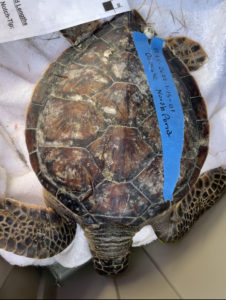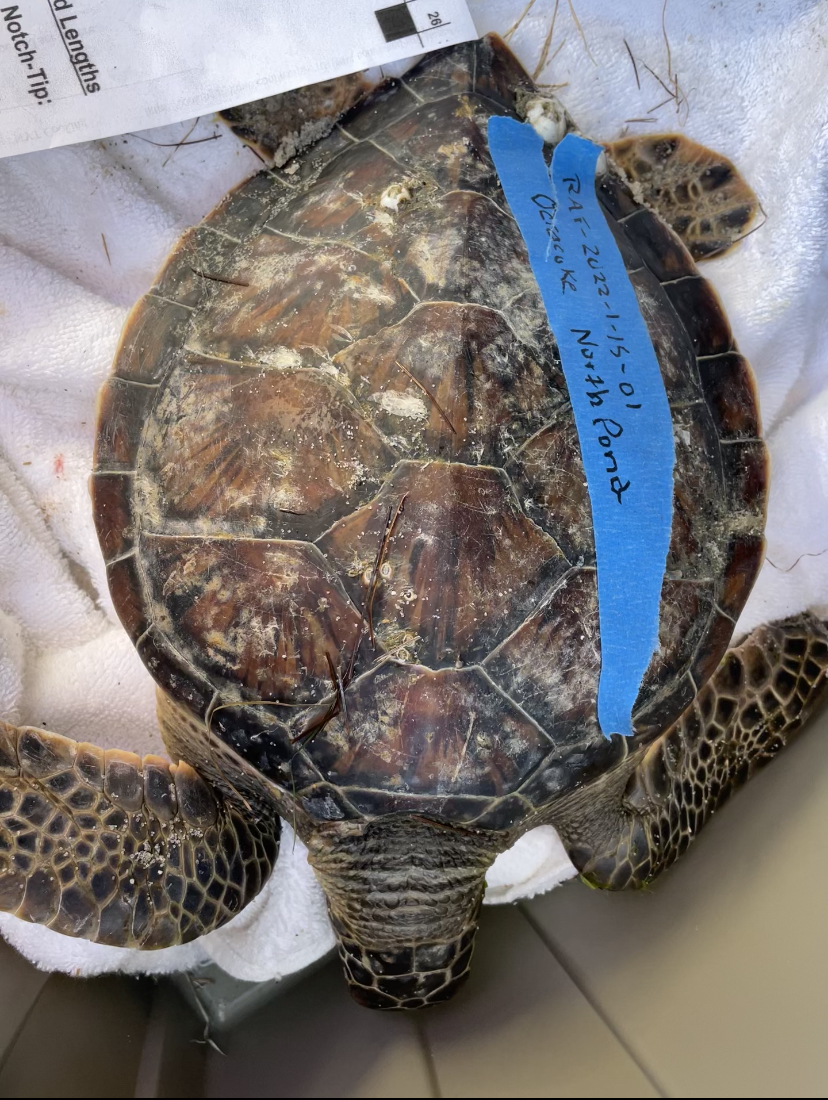This month Ben Ranelli, a former biological technician at Cape Hatteras National Seashore, tells us all about winter challenges for sea turtles and how you can help.
Winter Challenges for Sea Turtles
By Ben Ranelli
Winter chills present animals across the globe with daunting challenges, and sea turtles are no exception. Though sea turtles are primarily adapted to warmer temperatures, they have several strategies to overcome the cold. For one, sea turtles may undergo prolific migrations of hundreds or even thousands of miles to seek out warmer waters. If they do encounter cooler waters, their large body sizes mean they lose less heat; the heaviest leatherback sea turtles, for instance, can weigh over 1,000 pounds, enabling them to conserve enough heat to survive as far north as Greenland. Though their weighty shells account for much of that mass, sea turtles also possess fatty tissues that help insulate their core. However, these adaptations are not always effective enough to prevent cold stunning: a dangerous hypothermic condition that threatens species already in peril.

A cold stunned sea turtle found in the North Pond of Ocracoke Island. Photo: NPS Volunteer R. Fordon.
Sea turtles are vulnerable to cold stunning because they are exothermic, meaning they rely on heat from the external environment in order to maintain a healthy internal body temperature. A sea turtle’s body temperature is determined not by the temperature of its blood, as the misleading phrase “cold blooded” might suggest, but by how much energy is used in its metabolism. Like other reptiles, sea turtles have a low metabolic rate meaning they don’t need to burn as much energy to function whereas mammals, like humans, use more energy and therefore maintain a higher internal body temperature. Having a low metabolism means reptiles don’t need to eat as much or as often to survive, but it also leaves them susceptible to the cold.
Cold stunning can occur after cold weather reduces water temperatures below 50 degrees Fahrenheit, especially in shallower bodies of water, like Pamlico Sound, which experience more rapid temperature fluctuations than the ocean. Juvenile sea turtles, which rely on the sound for protection in their early years, are also more likely to become cold stunned because their smaller size doesn’t retain as much heat as larger adults. If sea turtles cannot get to warmer waters, they may experience hypothermia and have difficulty maintaining their body temperature. Unable to move, the cold stunned turtles float to the water’s surface where they are vulnerable to predators, starvation, and disease. Oftentimes wind or currents may strand them on beaches where, if the temperature remains cold, they require special assistance to survive.
National Park Service staff and volunteers monitor Cape Hatteras National Seashore for cold stunned sea turtles so they can be transported to receive proper veterinary care. Already in 2022, cold stunned sea turtles have been found on both Hatteras and Ocracoke Island. Timing is crucial for the survival of cold stunned sea turtles, and the sooner the animal can receive veterinary care the more likely it is to survive. If you encounter a stranded sea turtle on Cape Hatteras National Seashore, call the park’s sea turtle stranding hotline: (252) 216-6892. Additionally, if you encounter a stranded sea turtle not within the park, such as on private property, the Network for Endangered Sea Turtles stranding hotline can be reached at (252) 441-8622. Even having these numbers saved as contacts in your phone can save critical time and perhaps the life of an endangered species. Ultimately, rescuing one sea turtle from a harsh winter may mean that a new generation of turtles will hatch on the Outer Banks when the warmth of summer finally returns once more.
To learn more about sea turtles at Cape Hatteras National Seashore, visit nps.gov/caha/learn/nature/seaturtles.htm
______________________________________________________________________________
Ben Ranelli is a former biological technician in the Ocracoke district of Cape Hatteras National Seashore. Originally from Connecticut, he began working for the National Park Service after previously conducting research at the University of Connecticut and the Smithsonian Conservation Biology Institute. Working with birds, mammals and turtles across forests, mountains and seashores, he has dedicated his time to understanding and sharing the incredible diversity of wildlife in the eastern United States.

